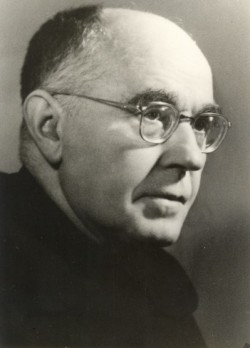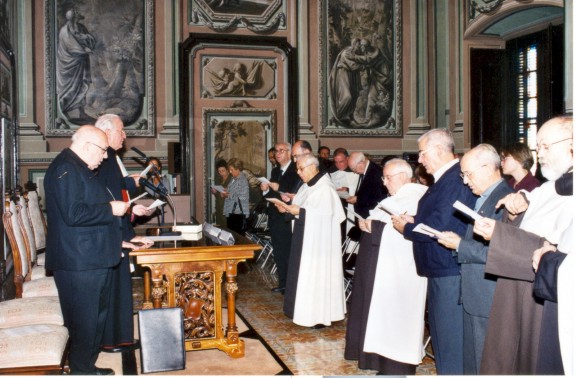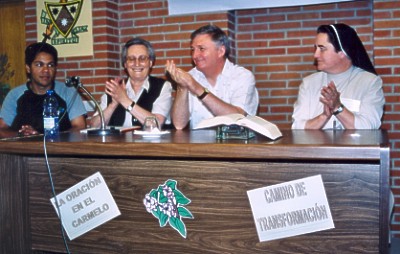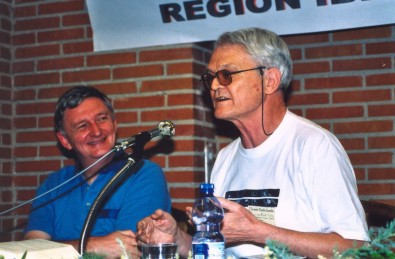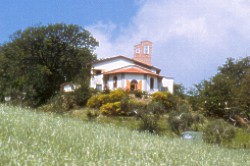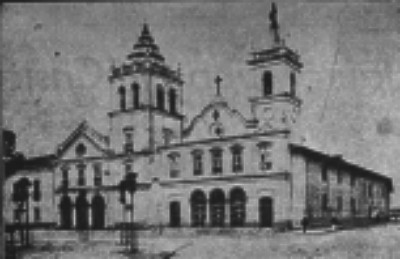|
no. 4 october - december 2003
Closure of the Diocesan Process of Canonization of Fr. Bartolomé Fanti M. Xiberta, O. Carm. The closure of the diocesan process for the canonization of Fr. Bartolomé Fanti M. Xiberta, O. Carm., took place on September 26, 2003. The ceremony, celebrated in the Episcopal Palace in Barcelona, was led by the Cardinal of Barcelona, His Eminence Ricard Maria Carles. A copy of the Acts of the Process and the documents were delivered to the Sacred Congregation for the Causes of the Saints by the Provincial, Manuel Bonilla Gutiérrez, O. Carm., and members of the Province of Catalonia. These documents will serve as the basis for elaborating the "Positio" that the theologians will study. Attending the closure ceremony were Fr. Felip Amenós, General Postulator of the Order, the Provincial of Catalonia, Fr. Rafael M. López Melús, of the Arago-Valentine Province, Fr. Balbino Velasco Bayón of the Province of Castille, and Fr. Fernando Millán Romeral of the Baetica Province, in addition to many religious and lay members of the Province of Catalonia. Fr. Xiberta was born on April 4, 1897 in the village of Girona, España, and died in Terrassa (Barcelona) on July 26, 1967. He was noted for living his Carmelite vocation in a very profound way and for his devotion to Mary. He accepted election as an Assistant General of the Order and distinguished himself in the Church as a theologian, researcher, historian, and as a teacher. He was a consulter for the Second Vatican Council and was a Consulter for the Spanish bishops. 100th Anniversary of the Hermanas Carmelitas de Madre Candelaria On September 13-14, 2003, the Hermanas Carmelitas de Madre Candelaria celebrated 100 years since the birth of the Congregation. The theme for the year was "Our Charism: To Be Communities of Prayer in the Midst of the People. 100 Years of Good Works in Charity and Service." On September 13, 1903, Mother Candelaria de San José (Susana Paz Castillo) started the Congregacion of Hermanas Carmelitas Venezolanas or "of Mother Candelaria" in Altagracia de Orituco, Venezuela. The Congregation was a reaction to the social climate in Venezuela in 1903 as a result of the war. With a group of young people, motivated by the unbreakable and contagious faith of Susana Paz Castillo and under the guidance of the zealous priest and later bishop Sixto Sosa, the fundamental characteristics of the charism of the Congregation were established: to work simply for those who suffer. Many difficulties confronted the Congregation in its early days. Providentially, on July 12, 1922, the Carmelites (O. Carm.) arrived in Porlamar, on the Island of Margarita (Venezuela) and Bishop Sosa gave them the parish of St. Nicholas of Bari. Mother Candelaria never suspected the great gift that the Carmelite presence would be to her and to the difficult and dangerous work her Congregation was involved in. The Congregation was aggregated to the Order on March 25, 1925. They received pontifical appropation in 1985. Mother Candelaria died in the odor of sanctity on January 31, 1940. In March 1969, her process for beatification was opened in Caracas, Venezuela and in 1967, the process was begun in Rome.
Carmelite Family: Xth Meeting on Iberian Peninsula The Xth Meeting of the Carmelite Family on the Iberian Peninsula took place at the retreat house "Cristo Rey" in Pozuelo de Alarcón (Madrid), from July 1-4, 2003. Some 140 member of the Carmelite Family took part. This year’s meeting was one of the largest gatherings ever of the Carmelite Family in the Iberian Region. The Hermanas Carmelitas del Sagrado Corazón de Jesús organized the days and the Prior General, Joseph Chalmers, and Carlos Mesters, General Councilor for Latin America, participated. The Prior General, Manuel Bonilla, Prior Provincial of Catalonia, and Rafael Leiva, General Council, were the main celebrants at the Eucharistic celebrations. The program was quite intense, centered around the theme "Prayer in Carmel, Journey of Transformation." During the second day, the Prior General developed the principal theme of the meeting, in three significant conferences: 1) In obsequio Jesu Christi: Friendship with Christ; 2) Methods of Prayer; 3) Towards Contemplation. Carlos Mesters, who directed the daily celebration of the Lectio Divina also gave three interesting lectures 1) Prayer in the Life of Carmel: Lectio Divina; 2) Prayer in the Life of Jesus; and 3) Prayer in the Psalms. In the morning of the final day, he spoke on "Prayer: The Spring of Brotherhood and Prophecy. The Superior General of the Hermanas Carmelitas, Sr. Encarnación Flórez, closed the meeting.
The next meeting will take place in Monserrat (Barcelona) June 29-July 2, 2004. This will be coordinated by the Catalonian Province and focus on the theme "The Laity." Two New Cardinals Assigned to Carmelite Parishes in Rome Two of the 30 new Cardinals named by Pope John Paul II in the recent Consistory have been assigned Carmelite parishes in the city of Rome. Cardinal Anthony Olubunmi Okogie, Archbishop of Lagos, Nigeria, was assigned the church "B. Vergine Maria del Monte Carmelo" di Mostacciano. Cardinal Marc Ouellet, Archbishop of Quebec, Canada, was assigned "Santa Maria in Traspontina" which is located on "Via della Conciliazione," not far from the St. Peter’s Square. Cardinal Ouellet took possession of the church on Sunday, October 26. In the next few months, the other Cardinals will also take possession of the churches in Rome which the Pope assigned to them. The assigning of a church symbolizes the Cardinals’ belonging to the clergy of Rome and therefore electors of the Pope.
The Carmelite Hermits of Monteluro: A New Sprout on an Ancient Tree On May 10, 2003 a gathering was held at the Hermits of Monteluro to thank the Our Lord and the Archdiocese of Pesaro for their first 25 years. The community of the Carmelite Hermits of Monteluro celebrated the 25th anniversary of their foundation with a conference given by Bruno Secondin, Carmelite and professor of spirituality at the Gregorian University in Rome. Since January 1, 2003, the Holy See has recognized the group as Carmelite hermits. The Carmelite community of Monteluro started in 1977 as an experience of contemplative life outside the traditional structures in the wake of the counciliar renewal: a life lived following the example of Mary. It began with three Discalced Carmelite sisters, one of whom died a few years ago. The community now has four sisters who, united by the same ideals, are a sign of a small but significant new way of living the contemplative life at the service of the people of God.
Bishop Hadisumarta, O. Carm., Resigning Pope John Paul II has accepted the resignation of Bishop Francis Xavier Hadisumarta, O. Carm, due to poor health. Bishop Hadisumatra is the former bishop of Malang, Indonesia and more recently Bishop of the Diocese of Sorong, Papua. The bishop consecrated his successor, Msgr. Datus Lega, a diocesan priest from Ruteng, Flores, on September 7, 2003. Bishop Hadisumatra arrived back in Malang on September 23, 2003, and moved into "St. Elias," the Carmelite retirement house, in Malang. His new postal address is: Biara Karmel, Bukit Dieng D-2, Malang 65146 and his e-mail address: fhadioc@hotmail.com XVI Congress for Secular Carmel in the Arago-Valentine Province From May 30 – June 1, the XVIth Congress on Secular Carmel was held in Onda (Castellón, Spain). A modest number of secular Carmelites came from various parts of the country to pray, live together, and enrich their formation during the three days. A number of conferences were given. The Prior Provincial, David Oliver Felipo spoke on "Fraternity: To Share in the Experience of God as Lay Carmelites." Juan Bautista Ferre Pérez, O. Carm., gave a conference on "The Third Order in Current Canon Law." Finally, Rafael María López Melús, O. Carm. spoke on "Jesus, Eucharist, and Mary in the Life of the Secular Carmelite." Financial Meetings Scheduled for November The triennial meeting of all Provincial, Commissary and General Delegation Bursars and their lay assistants took place at the Domus Carmelitana from the November 5 – 8, 2003. The meeting provided an opportunity for all participants to learn about the growth and needs of the Order as well as to understand and appreciate the needs and realities of each Province, Commissariat, and Delegation of the Order. The meeting was also an opportunity for individual bursars and their assistants to get to know each other and to exchange information and experiences that will help each in being responsible and accountable stewards in promoting Carmelite spirituality and ministry in today’s world. The 10 members of the International Financial Commission, including the three new lay members of the commission, also participated in the triennial meeting. Immediately after the triennial meeting, the International Financial Commission held its annual meeting from the November 10 - 13 at the Curia House. The new lay members of the Commission, Bernard Crean from the UK, an expert in investments, Pier Luigi Simoncelli from Italy, an expert in financing, and Jeff Cull from the USA, an expert in fundraising and development, participated for the first time. The Carmelite members of the Commission are: Eduard van Aaslum (Neer), James DesLauriers (Curia), Gian Dominico Meloni (Ita), Antonio Monteiro (Lus), Daniel O’Neill (PCM), Wilmar Santin (GerS-B) and Franciscus Sulistyo (Indo). IX OCARM-OCD of Latin America and the Carribean Meeting The IX Meeting of the Joint OCARM-OCD Commission for Latin America and the Carribean was held in Santiago, Chile, September 21-26 in the Sanctuary of St. Teresa of the Andes. The meeting focused on Carmelite formation. Some 16 people, including men, religious sisters, and lay members of the Carmelite Family attended. Since 1994, the Commission has met to reflect on the living out of our Carmelite charism within the Latin American Church and at the service of that local Church. The Commission began with just men, nominated by both the OCARM and OCD General Councils. Now it has been expanded to include women religious and lay people so that the entire Carmelite Family is represented. It was decided to continue these meetings involving people from the whole continent every three years while the work would continue, in the meantime, on a national level. The next meeting was sent for 2006 in Mexico. Province of Rio de Janeiro Celebrates 100 Years of Restauration In 2004, the Province of Rio de Janeiro will celebrate 100 years since its restauration. To prepare for this anniversary, the Province will have the celebration as the topic of its next annual meeting. At the beginning of the 20th century, in 1904, the members of the Dutch Province, at the request of then Prior General Pius Mayer, accepted the challenge to restore the Province of Rio which at that time had only two members. The decline of the Province was the result of a series of anticlerical and anti religious order laws. This negative situation began in 1762 when the Marques of Pombal, Prime Minister of the Kingdom of Portugal, created some laws prohibiting novitiates in the Kingdom, including Brazil. He also created difficulties for opening up other religious houses. In 1764, the Province had 257 members but by 1780 the number had fallen to 180. The situation became worse with the independence of Brazil and the proclamation of a republic. With the republic and the separation of Church and State, the Church of Brazil finally organized itself in accordance with the norms of the Holy See. The religious orders could follow their own constitutions, and the novitiates could reopen. However, the non Brazilian religious were expelled and the acceptance of novices required permission of the government. The situation should have gotten better but the Order had lost many members and in 1890, one year after the proclamation of the Republic, the Rio Province had lost almost all of it property and had only three members, each over the age of 70. Pope Leo XIII worried about these difficulties and the loss of so much of the Church’s patrimony. The practice of the Brazilian government was to incorporate the monastery property after the death of the last member of that monastery. So in 1891, the religious houses and properties of the religious passed to the jurisdiction of the bishops, in an attempt to preserve the patrimony of the Church. The Order had made two previous attempts, during the Generalates of Angelo Savini and Luigi Galli, to restore the Brazilian provinces but had no success. In 1904, seven Carmelites were sent in response to Mayer’s request. With additional vocations from Holland, by 1922 the Rio Province was healthy enough to begin accepting native Brazilian vocations. In 1954, the province was able to accept the challenge of Prior General Kilian Lynch to restore Carmel in Portugal. That undertaking had great success. Until the Second Vatican Council, Rio was one of the larger provinces in the Order in terms of numbers of members and was opening new foundations. The Province of Rio today has 15 houses and 60 professed members. The General Council accepted the suggestion to hold the 2005 General Congregation in the Rio Province in order to participate in the celebration of the centenary.
|
|
RETURN TO THE INDEX FOR 2003 | RETURN TO THE INDEX FOR THIS ISSUE INDEX OF CARMELITE
WEBSITES |
